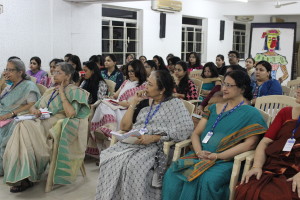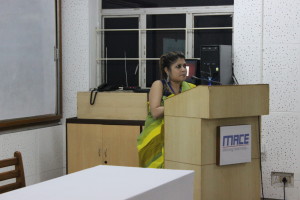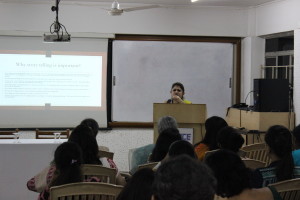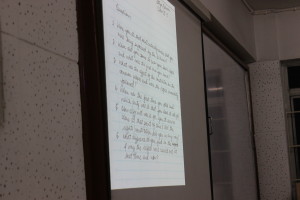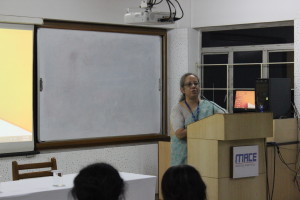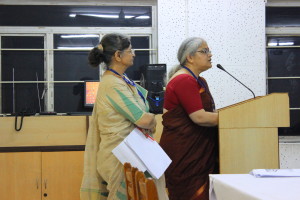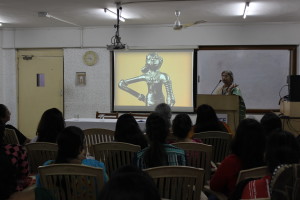Every year, PeaceWorks hosts international conferences on teaching history, as a part of the History for peace project. Each conference is well attended, with diverse voices and speakers from the field of academia, art, education and civil society. With all this input, we often wonder how it is being translated in the classroom. In other words, what is the transition from conference to classroom? Is there any?
It is with this aim of understanding how educators translate what is presented to them and take it to their students that ‘ Conference to Classroom—a series of workshops’ has been initiated.
Chapter 1 of this series was held at Modern Academy of Continuing Education (MACE) on 18 September. The facilitators in the workshop were educators from Modern High School— Ms. S. Chatterjee, Ms C. De Bakshi, Ms S. Biswas, Ms. A. Sen and Ms. S. Saha—all of whom had attended The Idea of India—the third History for Peace conference. They presented to a group of 45 participants, ideas and concepts from the conference that they took back to the classroom as lessons.
After a brief introduction by Meena Malhotra, Director, PeaceWorks, about the History for Peace project, its aims and objectives as well as the conference in order to set the context behind the workshop, we started with the presentations.
Ms. S. Chatterjee’s presentation was titled ‘Tell Me Your Story’, based on her main takeaway from the conference—storytelling—how every narrative can be in the form of a story. Her lesson ideas were based on T. Sanathanan’s presentation at the conference-where he spoke about four of his projects, each using art and narratives from the Sri Lankan Civil War- giving voice to those who are often ignored in history textbooks. Ms. Chatterjee spoke about how it is important to introduce qualitative research methods in the classroom and how students sometimes baulk at having to conduct interviews (she cited her own example). To combat this, she uses storytelling-where she asks students to identify a particular issue and to make that, and perhaps the place where they would like to do their fieldwork— the focal point of the story. This technique allows the students to overcome their own hesitations, makes the class interesting and relevant and also allows unheard voices to be heard.
Ms. C De Bakshi’s presentation was titled ‘Interviewing Your Grandmother- Rights and Perception Through the Eyes of Your Grandmother’. This lesson was inspired by what Jerry Pinto had said during his talk-about how it is important to get to know one’s mother. Ms De Bakshi used this concept in her class 9 civics class—incorporating storytelling in what is otherwise considered a very dry subject. The assignment for the students was to interview their grandmother (many of whom were born in the mid-late 1940s) about their rights. The questions included what life was like under British rule, what they knew about the Constitution, when they first voted (if they voted for the person/ party of their choice or whether they were told whom to vote for) and if there was anything they missed about undivided India. This led to discussions about issues such as equality before the law, discrimination, equal opportunity employment, untouchability and so on.
Ms. S. Biswas’s presentation—‘Monuments Rap: Defining features of Indian architecture through song’—was also based on Jerry Pinto’s session. During his talk, he had mentioned that he had asked his students to describe Marx and his teachings through a qawwali. The process was very interesting, because not only did the students have to come up with appropriate lyrics, they also had to work on bringing across the qawwali atmosphere. Ms. Biswas—who was also very influenced by Hamilton, the Broadway musical— worked on a similar theme with her students in Class 9, where the students had to develop raps about monuments like the Qutub Minar and the Sanchi Stupa. The students worked in groups for this, which works well to engage all types of learners.
Ms S. Saha and Ms A. Sen engaged with the idea of history-whose history is it, where does it come from? These were questions that were brought up during the first session of the conference—the conversation between Romila Thapar and educators. Ms. Saha showed the participants a picture of a Rs. 5 coin and asked them how they would write the history of 2017, using just that coin, hundreds of years from now. She emphasised that it is very important for students to ask questions and challenge ideas. Using photographs of the Indus Valley Civilisation—commonly found in History textbooks—Ms. Sen spoke about how it is important for students to analyse the photographs, above and beyond what is obvious and how one can reconstruct history using these clues.
The workshop was an interesting and useful one. Many of the participants in the workshop were teacher trainees from MACE and they identified quite a few points that they could use in their classrooms in the future.
Click on the links below to download the lesson plans
Monuments Rap Lesson Plan– Ms. Sunita Biswas, teacher, Modern High School for Girls
Tell me your story-lesson plan– Ms. Sreyasi Chatterjee, teacher, Modern High School for Girls
TELL ME YOUR STORY-Presentation by Sreyasi Chatterjee
Right to Equality Lesson Plan– Ms. Chitralekha De Bakshi, teacher, Modern High School for Girls
Understanding Sources Lesson Plan– Ms S. Saha and Ms A. Sen, teachers, Modern High School for Girls
Using evidence to recreate history-lesson plan– Ms S. Saha and Ms A. Sen, teachers, Modern High School for Girls
– Paroma Sengupta

